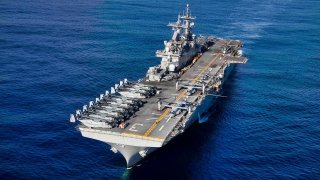Wasp-Class: The U.S. Military's Mini Aircraft Carriers? Maybe So.
Both the Harrier and the F-35B are V/STOL-equipped jets, capable of operating from the relatively small deck of the Wasp-class ships.
The Wasp-class is a U.S. Navy-operated class of landing helicopter, or LHD, amphibious assault ships. Some would even call it a mini aircraft carrier of sorts.
Essentially, the Wasp is an upgraded version of the Tarawa-class; the more advanced Wasp is capable of carrying more advanced aircraft and landing craft. Indeed, the Wasp is capable of carrying nearly one entire U.S. Marine Corps Marine Expeditionary Unit, or MEU.
The purpose of the LHD is to transport – and then support – an MEU. Transporting the MEU from sea to shore aboard landing craft and/or helicopters, the LHD can then support the MEU with onboard jump jets like the AV-8B Harrier II or F-35B Lightning II.
Both the Harrier and the F-35B are V/STOL equipped jets, capable of operating from the relatively small deck of the Wasp-class ships.
Wasp-Class: Eight Were Commissioned
In all, eight Wasp ships were built. Seven remain in service. The USS Bonhomme Richard was severely damaged when a fire broke out on board and subsequently decommissioned. The first of the Wasp-class ships was commissioned in 1989, all remain reliable vessels of U.S. force projection with the exception of the USS Bonhomme Richard.
While based on the preceding Tarawa, the Wasp does feature some distinct differences. First, the Wasp was built to accommodate the Harrier jump jet and the Landing Craft Air Cushion (LCAC) hovercraft; the Wasp also features a ship bridge that has been placed lower than in the Tarawa; with the Wasp, the command control facilities were relocated inside the hull; Unlike the Tarawa, the Wasp does not feature 5-inch Mk 45 naval guns on the forward edge of the flight deck; and the Wasp is 24 feet longer (to make room for the LCAC).
The final measurement for the Wasp is 831 feet long with a 104 feet beam and 27-foot draft. The ship displaces 40,500 tons. Two steam boilers are connected to geared turbines to power the ship, each delivering 70,000 shaft horsepower to two propeller shafts.
Although, it should be noted: the last Wasp-class ship, the USS Makin Island, was fitted with two General Electric LM2500 geared gas turbines. The result is a Wasp-class that can reach 22 knots per hour and a range of 9,500 nautical miles.
Amphibious Landing Attack Ships
The Wasp facilitates amphibious landings with either landing craft or helicopter. The ship was designed with a 266x50x28 foot well deck – fit for carrying and launching three LCACs, twelve Landing Craft Mechanized, or 40 Amphibious Assault Vehicles, or AAVs (another 21 AAVs can be stored on the ship’s deck).
For helicopter landings, the Wasp has nine helicopter landing spots – but the amount of helicopters on the ship varies depending upon the mission profile.
Typically, the ship carries six Harriers or six F-35Bs, four AH-1W/Z Super Cobra attack helicopters, twelve V-22 Ospreys, four CH-53 Super Stallions, and four Bell UH-1Y Venom utility helicopters. But the Wasp’s aerial cargo can be reconfigured to carry up 20 Ospreys, or alternatively, 20 Harriers or F-35Bs.
Two aircraft elevators move the ship’s jets and helicopters between the hangar and the flight deck. In addition to all of the aircraft and landing craft, the Wasp can host 1,894 Marine Corps personnel.
The Wasp itself is well armed, carrying Mark 29 octuple launchers, Mark 49 launchers, 20 mm Phalanx CIWSs, 25 mm Mk 38 chain guns, and 50-caliber machine guns. The Wasp is also outfitted with countermeasures including Mk 36 SRBOC chaff and decoy launchers, an AN/SLQ-25 torpedo decoy, AN/SLQ-49 chaff buoys, a Sea Gnat missile decoy, and an entire AN/SLQ-32 Electronic Warfare Suit.
The entire Wasp lineup was built by Ingalls Shipbuilding at Pascagoula, Mississippi, which is where the Wasp’s successor, the America-class, is currently being built. Despite two America-class ships already being in service, the Wasp still holds value as a transporter of MEUs. T
The Wasp may retain its relevance well as the U.S. Navy grows more central to U.S. military doctrine; the U.S. is pivoting to Asia after two decades mired in Middle Eastern combat – making the Navy, and its ability to facilitate amphibious attacks, much more important than it had been during conflicts against desert nations like Iraq and Afghanistan.
Expert Biography
Harrison Kass is a prolific defense writer with over 1,000 articles published. An attorney, pilot, guitarist, and minor pro hockey player, he joined the US Air Force as a Pilot Trainee but was medically discharged. Harrison holds a BA from Lake Forest College, a JD from the University of Oregon, and an MA from New York University. He lives in Oregon and listens to Dokken. Follow him on Twitter @harrison_kass.


